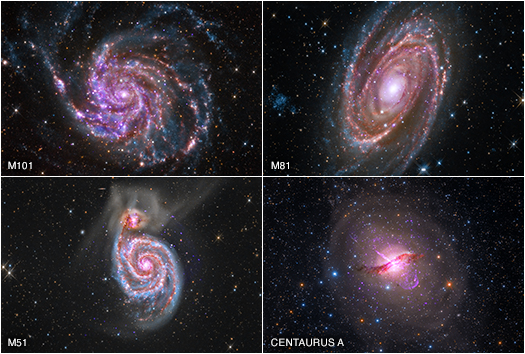Amateur astronomers have teamed up with the pros to produce four stunning multiwavelength images of the galaxies M101, M81, M51, and Centaurus A.

X-ray: NASA/CXC/SAO; Optical: Detlef Hartmann and Rolf Olsen; Infrared: NASA/JPL-Caltech
Astronomy has long benefited from the effort and dedication of amateur stargazers, so in the spirit of Global Astronomy Month, a new collaboration has combined the power of spacecraft observatories and amateur scopes to release a quartet of stunning images.
Each galaxy shines in a composite of wavelengths. Purple represents X-rays gathered by the Chandra X-ray Observatory, red corresponds to Spitzer Space Telescope’s infrared data, and the optical images gathered by amateur astronomers Detlef Hartmann and Rolf Olsen show in red, green, and blue.
Amateur astronomers have the luxury of collecting long exposures of even nearby, well-studied objects because, unlike their professional counterparts, they have no waitlist for telescope time and can observe for as long as the sky allows. This freedom — along with new technology — allows for “a dedicated amateur astronomer [to] produce images that rival those of professional ground-based observatories from just ten years ago,” writes Chandra Science Imager Joe DePasquale in a recent blog post.
DePasquale embarked on the collaboration as a way to forge relationships between the professional and amateur worlds following the Northeast Astro Imaging Conference last fall. He set out to find several high-quality images to combine for a multi-wavelength composite and came across the work of Hartmann and Olsen. Both were excited to undertake the project. Hartmann imaged several candidate objects that already had good data from Chandra and Spitzer from his remote observatory in the Austrian Alps. And Olsen imaged Cen A using a 10-inch self-built telescope in Auckland, New Zealand.
The composite images capture galaxies in our cosmic backyard, three of them grand-design spirals. M101, 21 million light-years distant, measures in at 70% larger than the Milky Way and achieved additional fame when it sported a supernova in 2011. M81 resides just 12 million light-years away. Centaurus A, the closest of the group at 11 million light-years and the only non-spiral, makes for a popular observing target among professionals and amateurs alike because of its bisecting dust belt and jet of particles blasting away from its supermassive black hole. About 30 million light-years away, M51 is merging with the smaller galaxy seen to its upper left.
These images demonstrate the wealth of publicly available data in NASA’s mission archives, which is free to use. More important, they are yet more evidence of what can be achieved when professional astronomers collaborate with experienced amateurs.
 0
0
Comments
You must be logged in to post a comment.